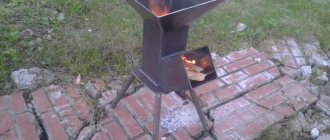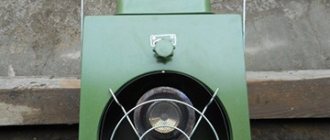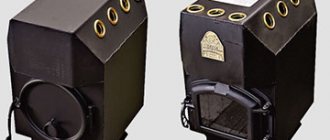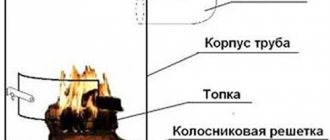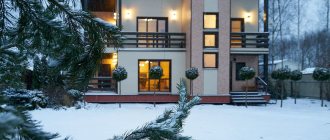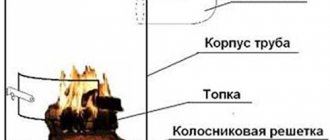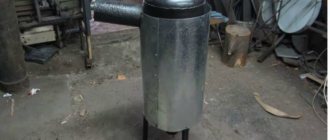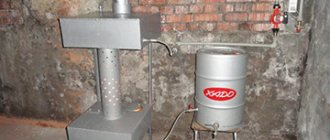Advantages and disadvantages
The Butakov stove has the following advantages:
- Cost-effective: one full deposit is enough to burn wood quietly all night – up to 10-12 hours.
- The condensate formed after combustion settles on the walls of the vertical pipe, after which it is again sent for combustion. This allows you to get rid of the unpleasant odor.
- Due to the unique design, heating occurs quite quickly, and heat distribution is uniform.
- Strong and thick walls with well-treated seams will prevent fire from breaking into the room.
- The oven can be used as a stove for heating food.
- The presence of a variety of models allows you to choose the optimally profitable option.
- Removing ash is quite simple.
- The stove is easy to install yourself, and its price is not very high: up to 30-35 thousand rubles.
- Stylish design allows the stove to fit into any interior.
The disadvantages include some design features of the devices:
- When the fuel burns out, the stove cools down quickly.
- It is necessary to carefully check the correct installation of the chimney so that smoke does not enter the room. It is also worth remembering that the pipes will have to be cleaned regularly.
- The outer walls become very hot, which can lead to a fire or burn to a person leaning against it.
Disadvantages of heating installations Professor Butakov
Like other heat generators, heating installations of the Butakov brand have certain disadvantages:
- Cooking food on Butakov brand stoves takes longer than on conventional heating and cooking heat generators.
- Many users note the difficulty of cleaning chimneys and stoves themselves after using raw wood or garbage as fuel. However, if you follow the instructions and burn the stove once every three days (use open burning mode), then this problem can be avoided.
When purchasing heat generators of the Butakov brand, you should clarify what energy carrier they can operate on. Not all models have the ability to use peat and coal as fuel resources. Professor Butakov’s units of the “Student” and “Engineer” series, according to reviews from their owners, do an excellent job of heating small country houses. Moreover, twigs, branches and other waste, which are present in sufficient quantities at the dacha, can be used as fuel for them.
https://youtube.com/watch?v=NHj9sJBlhQU
History of creation
The stove runs on wood, pellets and other solid fuels
The first example of such a stove was made in 2002 in the north of the country, in the Novosibirsk region. Just two months after this, the necessary certificates were received, and by 2004 a patent for the invention was issued. Its developer is a specialist in the field of heating engineering E. Yu. Zubkevich, who named the stove in honor of his relative Professor S.E. Butakova.
A year later, the inventor entered into an agreement with the Termofor company, which mastered the production and production of products. For a number of reasons, cooperation with her was suspended in 2008 and the patent owner remained out of business. To date, the production of these furnaces has been established on an industrial scale.
Technical features of furnaces
In the Gymnasium Student and Associate Professor series, there are several design differences. But there are also general characteristics and operating parameters inherent in each model:
- The heating principle - the oven belongs to the class of convection equipment. Heating is carried out through convection channels, tubes through which cold air is taken in and hot air is exhausted. The special design of convection channels ensures rapid heat transfer. Heat enters the room immediately after kindling, after 3-5 minutes.
Possibility of cooking - convection ovens do not have a special cooking surface. For cooking or heating food, the upper horizontal surface is used.
Operating principle: Termofor stoves are long-burning equipment. During operation, the principle of pyrolysis or gas generation is used.
In addition to the general characteristics and design features that each model has, there are significant differences. In order not to make a mistake when choosing, you should study the description of furnaces from the Termofor company.
Furnaces Gymnasium student
Long-burning heating stove by Professor Butakov Gymnasium student, designed for heating rooms with a maximum area of up to 100 m³. The main type of fuel is firewood, but the use of pressed briquettes is allowed.
The Gymnasium Student series has several differences:
- Combustion chamber volume 78 l. The gas generation mode and the large capacity of the firebox make it possible to extend the operation of the furnace from one load to 6-8 hours.
Inside the structure there are convective pipes, with the possibility of connecting additional air ducts, for heat removal and heating of adjacent rooms. Heating of the room is carried out using a combined method. In addition to convection, a very hot metal stove body is used to heat the room.
Metal convection heating stove Termofor Gymnasist, weighs only 55 kg. For ease of installation, a special stand is provided.
The hob of the Termofor Gymnasist heating and cooking stove is designed as the upper horizontal surface of the body. Convection channels come out so as not to interfere with the installation of dishes, if necessary, cook or heat food.
| Model | "Gymnasium student" |
| Maximum volume of heated room, cubic meters. m | 100 |
| power, kWt | 6 |
| Overall dimensions (WxDxH), mm, pipe up | 370x530x780 |
| Weight, kg | 55 |
| Fire door opening, mm | 250 |
| Combustion chamber volume, l | 78 |
| Maximum fuel loading volume, l | 34 |
| Maximum log length, mm | 440 |
| Chimney diameter, mm | 120 |
| Recommended chimney height, m | 5 |
| Convection pipes: diameter, mm / quantity, pcs. | 40/8 |
The Gymnasist stove is suitable for small rooms up to 60 m², simultaneous cooking and for heating the main and adjacent rooms.
Furnaces Associate Professor
The Termofor Docent wood heating stove, unlike the Gymnasist series, is designed for heating large areas with a total area of up to 250 m². The main differences of the modification:
- Possibility of choosing a complete set - the series includes models with doors that have a glass insert and are completely blind.
The weight of the structure is the mass of the body is about 160 kg, the volume of the combustion chamber is 275 liters.
The main type of fuel is wood with a moisture content of no more than 20%.
Operating principle - the design includes special jets for afterburning exhaust gases, which increases heat transfer by 10-15%.
Construction material – the main body is made of steel. Air heating stove Professor Butakov Associate Professor, comes complete with a cast iron door with glass. The advantage of the solution is the absence of door deformation, even after several years of operation. It is possible to choose a blind door that does not have glass.
| Model | "Assistant professor" |
| Maximum volume of heated room, cubic meters. m | 500 |
| power, kWt | 25 |
| Overall dimensions (WxDxH), mm | 570x820x1000 |
| Weight, kg | 164 |
| Fire door opening, mm | 290x340 |
| Combustion chamber volume, l | 275 |
| Maximum fuel loading volume, l | 100 |
| Maximum log length, mm | 600 |
| Chimney diameter, mm | 150 |
| Recommended chimney height, m | 6 |
| Convection pipes: diameter, mm / quantity, pcs. | 70/14 |
Furnaces from the Butakov company, Docent series, are used for full heating of large rooms. To do this, air ducts are connected to the convective channels. The upper horizontal surface of the stove, as in the Gimnasist modification, is intended for cooking or heating food.
The lineup
Today there are many models of the Butakov stove on the market. Below we will consider the main ones.
- The Gymnasist device, with a power of only 7 kW, is capable of heating up to 100 m² of area. The height of the chimney is 5 m.
- The Student stove (9 kW) can heat a room up to 150 m². The maximum fuel volume is up to 20 kg. The height of the chimney is 5 m.
- Professor Butakov’s “Engineer” unit (15 kW) will heat a room up to 250 m². The maximum fuel volume is 40 kg. The height of the chimney is 5 m.
- The Docent stove (25 kW) will heat a home up to 500 m². The design can hold up to 100 kg of flammable substances. The height of the chimney is 6 m.
- The “Professor” device (40 kW) is capable of heating up to 1000 m² of housing. The maximum fuel volume is 200 kg. The height of the chimney is 8 m.
- The Akademik unit (55 kW) can warm up a house with an area of up to 1200 m². The stove can hold up to 240 kg of flammable material.
Each model has its own dimensions. The larger the fuel space and firebox, the larger the dimensions of the stove.
The optimal choice of device depends on its purpose and the area of the premises requiring heating.
The compact stove “Gimnasist” can heat up to 100 square meters. meters. Its chimney goes up, so this unit is suitable for country houses and garage buildings. For other models, the chimney exits to the top or is located at the rear of the structure. They are mainly installed in large rooms.
Characteristics
There are several models of the “Engineer” stove; in this case, we will look at a model of a wood-burning stove from the Termofor company. Its price is approximately 14,250 rubles. (without chimney).
This is what the oven looks like in the photo:
| Heating area, m³ | 250 |
| power, kWt | 15 |
| chimney, Ø mm | 120 |
| chimney outlet | Top/back |
| Height of the chimney, m (minimum) | 5 |
| Firebox volume, l | 120 |
| Door | With glass/without glass |
| Dimensions (depth, width, height), mm | 765*440*895 |
| Maximum load of firewood or coal, l | 40 |
| Maximum length of logs, cm | 45 |
| Boiler material | Metal/steel |
| Firebox material | Metal/steel |
| Unit weight, kg | 113 |
| Manufacturer country | Russia |
The history of the origin of the stove.
Butakov's stove A popular professor at the Polytechnic University and heating engineer from the Urals, Sergei Efimovich Butakov, has created a number of economical boilers that run on solid fuel.
Depending on the model, they are capable of heating rooms with a volume of 100-1200 cubic meters. These devices have been successfully tested in many regions of Russia, including cold Siberia. The professor’s inventions received general approval and were able to pass state certification. Now many companies offer Butakov furnaces, but it is very important to choose among them those that can provide quality products from experienced manufacturers
The professor's path to creating these heating devices was not easy. He constantly improved his devices. Thanks to this, the scientist was able to achieve excellent operation of the furnaces, the absence of an unpleasant odor in the rooms when heating them, minimal fuel consumption and a variety of its types. Through trial and error, Butakov was able to create the ideal device for heating buildings, which is becoming more and more popular day by day.
Buying tips
In order for an ignorant user not to make a mistake when buying a stove, it is necessary to know how the original Novosibirsk Termofor product differs from a fake. Considering that the product is designed for long-term combustion, high-quality material is used for its manufacture: thick steel for the body and durable cast iron for the grates and doors. It is the design of the firebox door that is the main difference between the original and the fake.
Depending on the modification, the cost of the structure starts from 15,000 depending on the model. Considering the high functionality and efficiency of the devices, the price of Professor Butakov’s “Student” stove is quite adequate, which allows everyone to economically heat their country houses.
Installation of the unit
The Butakov stove for a bath is installed in the center of the steam room or between the steam room and the dressing room (washing compartment). For a fairly powerful installation, the second option looks preferable. In this case, the combustion door is removed from the steam room, which makes it possible to load fuel without entering it.
When installing the stove, the following recommendations should be followed. It is best to install the stove on a specially equipped concrete platform. If it is not possible to arrange it, then reliable fire-resistant protection must be provided on the floor. To do this, a steel sheet with a thickness of at least 4 mm and sheets of asbestos cardboard with a thickness of at least 10 mm are laid.
The stove may be installed at a distance of at least 40 cm from combustible elements of the bath structure. The adjacent section of the wall of the structure is also insulated with fireproof material. Such a screen must exceed the height of the device by at least 30 cm.
A steel sheet measuring at least 50x60 cm must be placed in front of the combustion chamber door. It is installed close to the stove and must completely prevent accidental contact of smoldering fuel on an unprotected floor. The chimney must have a total length of at least 5 m. The areas where the pipe passes through the ceiling and roof are subject to additional insulation. All pipe joints are sealed with a special, heat-resistant silicone-type sealant.
When operating the stove, the following nuances must be taken into account:
- The stove can only be heated with solid fuel (wood, coal, peat, etc.). It is strictly forbidden to use flammable liquids for kindling (gasoline, kerosene).
- The furnace body heats up to a high temperature, and therefore it is necessary to install guards to prevent accidental touches.
- Loading fuel into a homemade installation is carried out as follows. The lid is removed along with the pipe, and firewood is laid, and small chips are poured on top of it and paper is laid. For lighting, you can use a wick on a long rod. After combustion begins, the lid returns to its place, and the metal profile welded to the pipe begins to compact the loaded fuel. While combustion is in progress, the air duct damper is completely closed.
- The chimney outlet from the housing must be free.
In general, with proper installation and operation, the Butakov stove is considered an absolutely safe device in terms of fire safety. This device is characterized by high efficiency and small dimensions, which ensures efficient heating in rooms of various types. If depressurization of the housing or other defects are detected, operation of the device must be stopped until they are eliminated.
All about stove installation Engineer
To facilitate installation, each Termofor oven comes with detailed installation instructions. The company has thought out a convenient and simple design that facilitates installation work.
To begin installing the Engineer furnace with your own hands, you should begin by determining the location. It will not be unimportant to decide which chimney to use when connecting.
To heat adjacent rooms, a heat sink is installed on air heating furnaces for routing air ducts, and a heating system pipeline is connected to water heating models. After installation, the stove will be able to effectively heat the entire building, and not just the room in which it is installed.
Requirements for placement
The efficiency and uniformity of heating largely depend on the correct location of the stove. For normal operation, the Engineer stove needs a large volume of air and no obstacles in the way of convection currents.
An essential condition is compliance with fire safety rules. Some points that must be followed are contained in the instruction manual. In particular, it states:
- The stove is installed on a non-combustible base.
Protection is provided for walls and ceilings (where the chimney passes) when installed in a wooden house. The section of the wall adjacent to the stove is insulated with non-flammable insulation, and then covered with steel sheet or brick.
The surface of the chimney is heated to a temperature of over 200°C, which, according to the rules of PPB, requires the use of a special passage unit filled with mineral insulation when passing through floor slabs and roofing.
The special design and the use of a special base simplifies the installation of the Engineer furnace and makes it possible to do the connection yourself.
Which chimney is better
Solid fuel heating equipment belongs to the class of furnaces with high flue gas temperatures. During combustion, inside the combustion chamber, the heating intensity reaches 450-550°C. Although due to the use of gas generation, the smoke at the outlet cools significantly, the temperature still remains sufficient to lead to burnout and deformation of a conventional steel chimney.
Additional requirements apply to traction characteristics. Insufficient pressure leads to backdraft, air locks and other operational difficulties.
Reviews from owners and practice have shown that the optimal choice for convection and water heating stoves is a sandwich pipe and a ceramic chimney. An additional advantage of the systems is the simple installation of the chimney yourself. Sandwich pipes and ceramics are assembled like a construction kit and do not require special skills for installation.
On the Internet you can find negative reviews about the stoves of Professor Butakov Engineer, but they are rather the exception to the rule. Basically, owners point out the advantages of Termofor products:
- Affordable price.
Long service life.
A simple design that allows for independent installation of the stove in the house.
Thermal efficiency due to the ability to connect to a water heating system and air ducts.
All of the above factors ensure uninterrupted and comfortable operation of the Butakov stoves of the Engineer series and explain the popularity of the models among Russian consumers.
Principle of operation
Operation
oven is carried out simultaneously by pyrolysis and convection:
- The pyrolysis process occurs directly in the firebox. In this case, the fuel does not burn, but simply smolders. If you close or open the door vent, you can regulate the flow of fresh air inside. During this process, a large amount of gas is released, which is sent to the second chamber, where, when mixed with oxygen, it is completely burned. At the same time, the air in the room always remains fresh.
- The convection process occurs in special pipes installed in the structure. Through channels mounted in the firebox with protruding ends at the outlet, hot air is directed directly into the room. Heating is carried out naturally. Cold air is taken in from the lower openings of the pipes. It passes through the entire structure and is sent upward while still hot. However, this leads to sudden changes in temperature in the chimney, which is why condensation is possible, which is a significant disadvantage of this design. But the problem can be solved if you install a pipe. Through it, the condensate will not escape outside, but will settle directly in the firebox, in which it will simply evaporate under the influence of heat.
Potbelly stoves and many pyrolysis units operate in approximately the same way, but there are still some differences. Among them the following are noted:
Pipes in the furnace are not installed arbitrarily, but at an angle
It is important to set the exact angle when arranging the structure yourself. The doors are not just hung on hinges, they contain a convection chamber, which contributes to faster and more uniform heating of the room. The oven, unlike some pyrolysis models, is quite easy to maintain. The ash pan is easy to remove and quick to clean
Among similar designs, it is the Butakov unit that is considered the most efficient, simple, and has high heat transfer.
Furnace installation
The unit can be placed in the center of the room or built into the wall, simulating a fireplace. In this case, two adjacent rooms will be heated at once.
When installing a stove, the main condition is the unhindered flow of air. The material must be fireproof, and for the base it is better to use a concrete screed
The chimney heats up quickly during operation and startup of the stove, therefore it is important to lay a thermal insulation layer between it and the roof
At the dacha, you can heat it with wood scraps, but the best fuel for such a design is pellets with high efficiency. The operating principle of the stove is as follows: smoldering occurs slowly, so the moisture content of the wood is not particularly important. Dry wood will burn the same way.
The combustion chamber must be extremely sealed. Carbon monoxide does not enter the room, so the stove can be placed next to the sleeping place. One bookmark should be enough for 18-20 hours. The Butakov unit will be the optimal solution when installed in a country cottage with a decent area, or in a country house.
Today, more powerful stoves are produced. For example, a new model “Akademik” with a power of 55 kW has appeared. This is a real record among heating devices of this type. Thanks to the modern design, installation is possible anywhere. A large range of models allows us to satisfy everyone's needs.
If you follow all the recommendations described above, you will be able to make an excellent device with a long-burning system without much expense.
Furnace design
Butakov's heating device is very simple. The unit consists of the following elements:
- ash pan for collecting combustion products;
- air outlet pipe;
- two-chamber firebox: one compartment is provided for connecting to gas, the second is for afterburning fuel;
- grate in the form of a damper;
- smoke channel.
The pipes run along the edge of both sides of the furnace, are arranged in two rows, close and cross in the upper part. Thanks to this design, the floor warms up well when cold air moves through pipes located in the combustion zone. Due to them, the heating area increases and the furnace walls do not burn out. Thanks to special jets with hot air inside, located at the top of the firebox, the secondary gas is burned in full. This once again confirms the efficiency of the device: the fuel burns out entirely, and the heat is retained indoors for a long time.
Division of Termofor Professor furnaces by type
The solid fuel air-heating boiler Professor Butakov Professor is available in two modifications, differing in the type of fuel used. The stoves can operate on wood and coal.
Prices for Professor stoves depend on the model:
Coal will cost a little more due to the peculiarities of the internal structure. The stove can be bought for 40 thousand rubles.
Regardless of the chosen model: wood/coal, Professor stove, it will last 8-10 years. For the first year of operation, a factory warranty is provided. In the event of a malfunction: burnout or deformation of the housing, the manufacturer is ready to replace the defective product with a new one.
Wood-burning stoves Professor
Metal heating stove Professor Butakov Professor on wood, characterized by an increased volume of the combustion chamber (400 l) and a productivity of 40 kW. Inside the body there are grate bars that ensure maximum burning of firewood and the complete absence of unburned residue.
In the internal structure of Professor Butakov’s heating and cooking stove for home, wood-burning, long-term burning, the gas generation process is used with maximum efficiency. The internal firebox is made in the form of a parallelepiped to improve the afterburning produced during combustion of carbon dioxide.
Wood-burning metal stoves for long burning, Professor Butakov, are distinguished by another design feature. Convection pipes pass inside the side walls of the combustion chamber and form a vault at the top, bending at an angle. It is believed that this particular arrangement of the channels ensures better intake of cold air and release of heated air into the room.
Furnaces Professor coal
The long-burning solid fuel coal air-heating boiler Termofor Professor has several differences from its wood-burning counterpart:
Heat-resistant glass on cast iron door. The decision to use cast iron helped solve the most common problems. Deformation of the firebox door was prevented, and it became possible to observe the flame. To prevent the glass from becoming covered with soot when burning, an anti-smoke system is provided.
The hermetically sealed firebox and internal design features are designed taking into account the possibility of using Professor Butakov’s long-burning stove in residential premises. When used correctly, smoke is prevented from entering the room. The power of the stove is enough to fully heat a building of 400 m².
To heat adjacent rooms, the Termofor company has developed a heat removal panel, through which several air ducts are connected to the Professor stove.
Safe installation of the stove and chimney
For installation you will need an asbestos board or sheet of iron
To install a chimney on an engineer Butakov stove, you will need to read the installation instructions, which describe in detail all installation operations. There is also a diagram for connecting pipes to the output manifolds of the unit.
When installing them, special attention is paid to the issue of fire safety, which is primarily manifested in the selection of a suitable location
The Butakov boiler, as a rule, is installed directly on the floor of a residential or industrial premises. It is placed on a flat surface covered with a sheet of iron on top of a ten-millimeter asbestos flooring. There are mounting holes on its base that allow the housing to be fixed to the floor if necessary.
During installation, it is important to ensure that the stove firebox and body are at least 380 mm away from the walls and floor. If it is impossible to provide the required gap, it is recommended to insulate the wall surfaces at a level of 25 cm above the top of the boiler
To do this, you can use one of the following methods:
- cover with a layer of reinforced heat-insulating plaster 25 mm thick;
- place a 10 mm piece of asbestos with a steel sheet on top on the protected surfaces.
To insulate the floor in front of the firebox door, you will need to lay a metal sheet of the required size.
It is also important to determine the exact location of the chimney pipe installation in the ceiling area on the ceiling surface. After marking it, a square hole is made in the selected area, insulated with basalt wool over metal sheets
According to the drawings, the Butakov stove is connected to the finished chimney using a special tee, which ensures that combustion residues of wood (soot) and condensate settle in it
Particular attention is paid to the quality of pipe joints, for which all joints of the gas exhaust system are sealed with heat-resistant sealant.
Device
Design of the "Engineer" furnace. (Click to enlarge)
In terms of design and principle of operation, the “Engineer” is practically no different from other models of heating stoves “PROFESSOR BUTAKOV”.
The body of the furnace-boiler is an all-welded structure of an original shape (truncated parallelepiped), made of steel and coated with black anthracite-colored silicone paint.
Inside the housing, in the front and rear parts, there are built-in convection pipes, through the lower part of which cold air is drawn in, passing along the housing, heated, rises, exits through the upper part of the pipe and is distributed throughout the room through special openings-air ducts.
The presence of a large replaceable grate ensures uniformity and duration of combustion of the firebox over its entire area. The bottom of the firebox is protected from burnout by a heat-resistant grate. As a result, all surfaces of the stove participate in heating the room.
The door rotates on hinges 120 degrees, has a special seal and a reliable locking mechanism.
These stoves use solid fuel as fuel - pressed cardboard, firewood, wood waste, peat, brown coal. At the bottom of the furnace there is a capacious box for ash, which is poured into it through the slits of the grate, and which can be emptied of ash without interrupting the operation of the furnace.
The base of the boiler has mounting holes for fixing the stove to the floor.
At the same time, the Engineer stove has a number of distinctive (besides the above) features and characteristics:
- she weighs 100 kg;
- its dimensions are 440×645×800 mm;
- firebox volume -120 liters;
- chimney pipe diameter is 120 mm;
- efficiency factor (efficiency) - about 85% (increased heat transfer is achieved through the use, like the Student furnace, of pipes with a large diameter and thinner walls.)
In addition, the Engineer series has 2 modifications:
- with steel door;
- with a cast iron door with heat-resistant glass.
Accordingly, prices for each model also differ: in different stores they vary between 14,000-16,000 rubles. and 18,000-20,000 rubles.
Furnace installation
Before installation, you should prepare a place for the heating stove. This does not require the installation of an additional foundation.
The stove is installed on the floor, on a flat, insulated surface (metal sheets on asbestos cardboard can serve as such a surface).
The base of the Butakov stove design is equipped with holes for fixing, so it can be fixed to the floor.
Adjacent walls also need to be insulated to a level 25 cm above the top edge of the stove. Plaster on a metal mesh or asbestos cardboard with a metal sheet serves as thermal insulation.
The distance from the wall to the stove must be at least 38 cm.
A metal sheet must be laid in front of the oven door.
The hole for the chimney should be thermally insulated.
The Butakov heating stove is installed in a prepared place made of non-combustible materials (for example, on a brick stand).
The last step in the installation is connecting the chimney to the tee and the stove.
Important! All pipe joints should be treated with heat-resistant sealant. Important! The chimney pipe should protrude 50 cm above the roof ridge
In this case, the part of the chimney located in open space must be insulated with material that can withstand temperatures up to +400 °C
Important! The chimney pipe must protrude 50 cm above the roof ridge. In this case, the part of the chimney located in the open space must be insulated with material that can withstand temperatures up to +400 °C
Be sure to insulate the hole in the roof with special material.
The space around the structure can be equipped with any heat-resistant and non-flammable material.
Furnace installation
For installation you will need an asbestos board or sheet of iron
To install a chimney on an engineer Butakov stove, you will need to read the installation instructions, which describe in detail all installation operations. There is also a diagram for connecting pipes to the output manifolds of the unit.
When installing them, special attention is paid to the issue of fire safety, which is primarily manifested in the selection of a suitable location
The Butakov boiler, as a rule, is installed directly on the floor of a residential or industrial premises. It is placed on a flat surface covered with a sheet of iron on top of a ten-millimeter asbestos flooring. On its base there are mounting holes that allow, if necessary, to fix the body to the flooring.
During installation, it is important to ensure that the stove firebox and body are at least 380 mm away from the walls and floor. If it is not possible to provide the required gap, it is recommended to insulate the wall surfaces at a level of 25 cm above the top of the boiler. To do this, you can use one of the following methods:
To do this, you can use one of the following methods:
- cover with a layer of reinforced heat-insulating plaster 25 mm thick;
- place a 10 mm piece of asbestos with a steel sheet on top on the protected surfaces.
It is also important to determine the exact location of the chimney pipe installation in the ceiling area on the ceiling surface. After marking it, a square hole is made in the selected area, insulated with basalt wool over metal sheets. According to the drawings, the Butakov stove is connected to the finished chimney using a special tee, which ensures that combustion residues of wood (soot) and condensate settle in it
According to the drawings, the Butakov stove is connected to the finished chimney using a special tee, which ensures that combustion residues of wood (soot) and condensate settle in it
Particular attention is paid to the quality of pipe joints, for which all joints of the gas exhaust system are sealed with heat-resistant sealant
Before starting installation, it is necessary to prepare the place where the unit will stand. To complete the task, it is not necessary to install an additional foundation. The stove can be placed on a brick stand.
Note! It is recommended to pre-insulate the installation site. Metal sheets are used for this purpose. The surface must also be flat, without drops
The surface must also be flat, without any drops.
The walls adjacent to the device must be insulated. Plaster mixture on a metal mesh is an excellent option for thermal insulation.
Important! The device must not be installed close to a wall. In this case, it is recommended to maintain a distance of at least 40 cm. Also, the pipe joints must be treated with a special sealant
Moreover, the space near the unit should not contain flammable materials
Also, pipe joints must be treated with a special sealant. Moreover, the space near the unit should not contain flammable materials.
By observing the above requirements, it is possible to avoid a fire.
Oven “Student”
This heating device is the best option for residential premises, as it has small dimensions and attractive appearance
, and is capable of heating a large area. The weight of the structure is 70 kilograms
, the fuel compartment
is 60 liters
.
Traditional units have a double combustion door, the outer door acts as protection. The “Student” design is provided with a special door made of cast iron with a viewing window made of fire-resistant glass. It should be noted that over time the window will turn black, so it may not be installed.
The unit can be purchased ready-made with the necessary components
. Depending on the store, this stove can cost approximately 20,000 rubles
.
Installation of the “Student” stove
The structure can be assembled with your own hands, in several stages
- First of all, it is recommended to prepare an assembly drawing or download a ready-made version on the Internet. This will make the job easier.
- Then you should prepare a place for the structure. The surface of the floor and walls must be finished with fire-resistant materials.
- Decide on the pipe exit area
. Then make a hole in the ceiling, which is covered with non-combustible materials. - Then the unit is installed on the prepared stand
. - All pipes
are installed sequentially using sealant . It is recommended to purchase sandwich pipes that prevent the formation of condensation and the penetration of smoke into the room. - A special “skirt” needs to be made on the outside of the pipe.
If the Student structure is installed at a short distance from wooden parts and surfaces
, then the walls must be covered with asbestos cardboard. It is recommended to fix galvanized sheets on top.
You need to carefully make a hole for the pipe in the ceiling. It should be several centimeters larger than the diameter of the chimney. The hole made must also be covered with fireproof materials, since this area is dangerous. The “Student” stove does not contain a water tank, but if hot water is needed in the house, you can additionally purchase the necessary container. To do this, you need to carefully connect the pipes, container and gate. All joints must be carefully sealed.
After all the components of the “ Student”
will be collected, you need to check the stove and light it. It should be noted that the first ignition implies a lot of smoke in the room
, as paints and various oils will fade.
Therefore, it is recommended to carry out the first start-up of the heating device outdoors
. If no defects are found, then the “Student” structure can be installed in the room.
Preparing pipes and parts
The oven has an outlet of 14 convection pipes. The diameter of the chimney outlet is 200 mm; we purchase it ready-made from a corrugated ventilation pipe.
For manufacturing we will need to prepare several parts. From 4 mm sheet steel we cut out:
- 2 side parts measuring 800/950 mm. The second dimension is the height of the structure;
- For the front and rear walls, we use a grinder to cut out parts 1110/670 mm. After final assembly, the protruding metal will be cut off and can be used as reinforcement for the base;
- for the top we cut out a piece measuring 350/950 mm. It is necessary to mark 6 holes of three pieces on the narrow sides and drill or cut them by welding. Pipes with a diameter of 40 mm will come out of them;
- for 2 side jibs, cut the workpiece to a size of 200/950 mm;
- for the base you can use a corner with a 100 mm shelf or a channel. 2 pieces 950 mm and 2 lintels 470 mm each. It is necessary to make holes in the base for the pipes, which must be coaxial with the top ones;
- For convection pipes we use steel parts with a cross section of 40 mm. 6 of them are straight, they run along the front and back walls. There are 4 holes on the jibs. 8 pipes will need to be bent to a certain angle. It is better to do this on a pipe bender.
You will also need to leave a sheet for making a door and an ash drawer. To make a grate, you can use a sheet 10 mm thick, making longitudinal grooves in it with a grinder. You can weld a grid from reinforcement or a rod with a diameter of 8-10 mm.
To install the grate, we will prepare several pieces of corner. It is better not to secure the grate tightly; this will make it easier to replace and maintain the stove. A hole is marked on the top part and made for connection to the outlet pipe. You will need to prepare a section with a cross-section of 180-190 mm and a length of 170 mm.
Advantages and disadvantages
Today, the modern “Engineer” boiler has been improved. Specialists have increased the diameter of convective pipes, and the pipe walls have become thinner. This change contributes to an increase in the open section, and heat flows improve heat transfer. Therefore, the main advantage of the stove is the cost-effectiveness of the model.
Main advantages:
- Increased efficiency. Each structural element is aimed at fulfilling its functional load. It helps heat the room and food.
- Eco-friendly. The firebox is designed in such a way that almost all the fuel burns. Therefore, ash does not emit harmful substances.
- Reliable and fireproof. The design is equipped with a sealed firebox that protects the room from open fire.
- Affordable and durable. The low price goes well with the quality.
- Design. The stove is not bulky, has an aesthetic appearance and fits into any interior.
Main disadvantages:
- Oxygen can enter the furnace through the ash pan.
- For cleaning, the pipe is disassembled into sections.
- The front part of the structure deforms over time.
How to install a Student stove
Detailed installation recommendations are provided in the operating instructions. Despite this, as practice and consumer reviews show, during installation work, the same mistakes are made.
Violation of the advice in the operating instructions leads to a decrease in the thermal efficiency of the stove, refusal of warranty service and rapid failure
It is important to pay attention to the correct location of the stove and ensure fire safety
Where is the best place to put the oven?
The Hydraulic stove is installed in the same way as a conventional solid fuel boiler. For placement, a boiler room with a ceiling height of at least 2.2 m and a non-combustible base is selected. The batteries are connected using special taps on the side of the case.
For air heating furnaces, due to the principle of operation and design features, a place is chosen for installation that provides unhindered air convection. Optimal location, in the center of a heated room.
If you plan to distribute heated air to adjacent rooms through air ducts, when choosing a location, take into account the need for connection using a heat extractor and air ducts. The stove is installed so that it is easy to route the corrugated pipe to other rooms.
The Termofor company additionally supplies heat removers from air ducts, designed for quick connection of a steel corrugated pipe for hot air distribution. When installing the stove, it is better to use branded components.
How to ensure fire safety
During operation, the walls of the oven become very hot, so thermal protection of walls and floors made of wood and other flammable materials will be required. The work is performed as follows:
Protection of walls from heat will also be required in places where the chimney is laid. When passing through floor slabs and roofing, a special fireproof cutting is installed. A spark arrestor is mounted on the chimney head.
What and how to heat the stove Student
Furnaces of the Student series belong to gas-generating or pyrolysis equipment that is demanding on the quality of fuel.
The heat generator must be heated with wood with a humidity of no more than 20-25%. When using raw fuel, the stove cannot be switched to gas generation mode; the wood will burn as usual, which will lead to an increase in fuel consumption and a decrease in efficiency.
The operating instructions indicate the possibility of using the following types of fuel:
Wood and peat briquettes are optimally suited for operating Termofor stoves. The use of briquettes increases the operating time from one stack. During the combustion of compressed fuel, 20-30% more heat is released than when burning wood.
It is prohibited to burn wood stoves with coal. The design and internal structure of wood-burning models is not designed for the characteristics of coal combustion.
How to light a stove correctly Engineer
The air-heating boiler Professor Butakov performed by the Engineer, working on wood and coal, a derivative model Hydraulic with a built-in water circuit, have a common structure and principle of operation.
The company has prepared some recommendations regarding the correct firing of stoves:
- Air pockets form in the chimney, especially after a long break in operation. If you immediately turn on the stove at full power, backdraft will appear and smoke will flow into the room. Therefore, to begin with, the stove and chimney duct are heated by burning a small volume of finely chopped splinters. The firebox is started at full power after 10-15 minutes of maintaining a low-intensity flame.
It is wrong to heat a stove exclusively with coal, and the Engineer and Engineer Hydraulic series are not intended for this type of fuel at all. The coal boiler is initially heated with wood. After heating the firebox and creating the required temperature, a portion of coal is poured on top. Some experienced users recommend that the fuel be laid in layers. A layer of firewood, a layer of coal. This prevents overheating of the combustion chamber, and during combustion, the soot burns out at the same time. Learning how to properly fire a Termofor Engineer coal stove is not at all difficult. After 2-3 kindlings in accordance with the instructions set out in the documentation from Termofor, the firebox will become a familiar and everyday activity.
All long-burning wood stoves for the Engineer house operate in gas generation mode. In order to force solid fuels to release flammable carbon dioxide, certain conditions must be created. After heating the combustion chamber to a temperature above 200°C, the gate valve is closed.
The characteristics and thermal efficiency of stoves declared by the manufacturer are only possible if the conditions for using firewood with a relative humidity of no higher than 20% are met.
Installation conditions for an air-heating boiler
So that, having bought an air-heating boiler, you are not disappointed in the choice, and you do not have any difficulties with installing the structure, it is worth knowing some of the nuances. They should definitely be taken into account:
- Installation of an air heating system and specifically a boiler is carried out only in the house during the construction process. A plan and necessary drawings must be drawn up in advance.
- This system will require a backup source of electricity.
- To increase efficiency, the boiler must be installed in a home, and the walls must have reliable thermal insulation.
- Ventilation of the room is necessary, since ventilation does not completely clear the air of gas.
- Air ducts may not be needed if partitions are not installed on the second floor or the area of the house is small.
If you want to heat your house using an air-heating boiler, you can save relatively well on installation and do everything yourself, taking note of a couple of basic recommendations.
It will not be possible to carry out all the work manually, or rather, not everyone. There are some things that are better to entrust to specialists, for example, calculations. To make the right choice of a long-burning air-heating boiler, you need to know the following characteristics:
- required power of the unit taking into account heat loss;
- the rate of warm air entering the rooms;
- all kinds of heat loss;
- air duct system parameters.
You can calculate the boiler power yourself depending on the available information.
It is necessary to decide on the installation location of the unit
There are no special requirements for the location, so in this case it is important to remember the main principles of installing gas or other equipment
How to choose the right solid fuel boiler for you
How does the oven work?
The operation of the Butakov furnace is based on pyrolysis and convection processes:
- Pyrolysis takes place in the combustion chamber - it is there that the fuel slowly smolders, unlike a conventional stove where wood burns. The oxygen supply is controlled by the door vent. The process is accompanied by the release of a large volume of gas, which enters the second chamber and burns when mixed with oxygen. Since carbon dioxide is efficiently removed from the room, the air in it remains fresh.
- The convection process takes place in special pipes, which are a structural element of the furnace. Warm air from the firebox enters the room through a pipe system and, due to natural processes, rises to the ceiling, moving around the room. In this case, cold air from the room enters the firebox through the intake pipes located at the bottom of the structure. The continuous, economical process allows the cubic capacity to be heated evenly.
What to make it from?
Several variants of furnace designs have been developed. This can be a simple barrel in which firewood is placed on top and the air flow is blocked by a gate valve. It will take more time to produce an analogue of industrial samples with a system of convection pipes and a separate gas combustion chamber.
The simplest and most uncomplicated scheme is a Butakov stove made from a gas cylinder. In this option, you can do without convection pipes or use 2-3 convection inserts.
We will examine in more detail the production of an analogue of an industrial design with a rectangular shape and a complete circuit of convection tubes and a system for long-term pyrolysis burning of wood. This design is the most productive and economical.
But during the manufacturing process it will be necessary to perform turning and drilling work. You can take the dimensions and bend angle from industrial sample pipes. The amount of material required for work depends on the chosen option and the dimensions of the furnace.
User manual
It is worth considering that the “Student” dacha stove is a gas-generating equipment that imposes special requirements on the quality of the fuel used.
- It is recommended to use firewood whose humidity does not exceed 25%, since rawer fuel will not allow the unit to switch to gas generation mode. This can provoke a decrease in efficiency with increased fuel consumption.
- For coal modifications, firewood is used as needed. To do this, you will need to completely pull out the grates. When using wood or peat briquettes, the gap between fillings increases significantly. It also generates 28% more heat than wood.
Attention! It should be taken into account that the design of wood-burning modifications does not involve the use of coal
